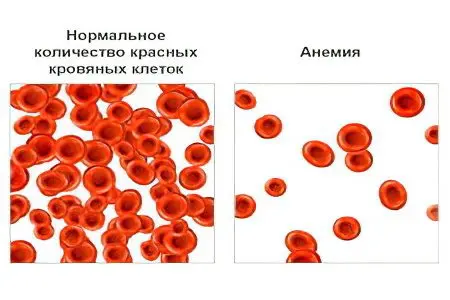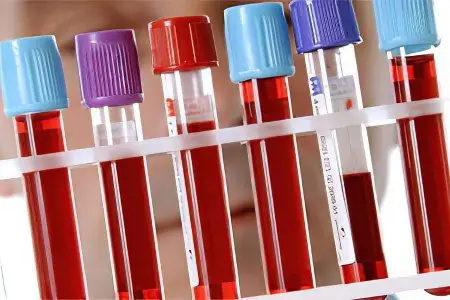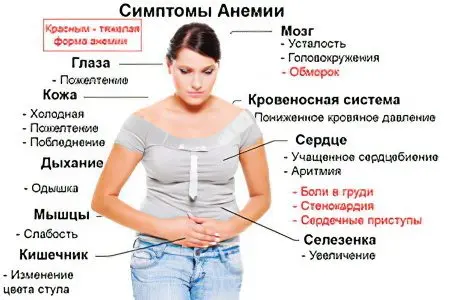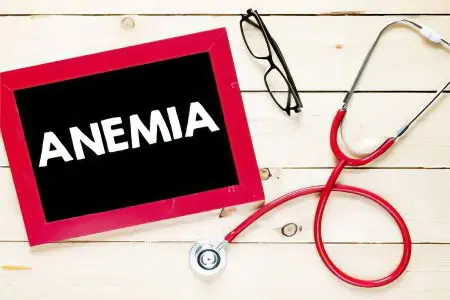Contents

The patient can only hear the diagnosis of “anemia” from a doctor. It often raises a number of questions. The first of them – what does this concept mean? Anemia is a disorder in the hemostasis system, which is characterized by a decrease in hemoglobin levels. Hemoglobin is a protein substance that contains iron atoms in its composition. Hemoglobin is part of erythrocytes – red blood cells.
Normally, the hemoglobin level in a healthy person is 110-155 g / l. If, according to the results of the examination, hemoglobin values are reduced to 110 g / l, they speak of anemia of the 1st degree. The maximum allowable hemoglobin norm for men is considered to be 110-120 g / l. However, this is not enough for the full functioning of the body.
Anemia 1 degree – how to determine?

It is possible to suspect anemia of the 1st degree by some symptoms, but this is not always possible. Often, pathology at such early stages of development does not give itself away. Therefore, a person learns about his diagnosis only in the doctor’s office, having come for the results of a blood test.
The asymptomatic course of the disease should not be misleading. Outwardly, a person may look completely healthy. The absence of any signs only indicates that the body has launched compensatory mechanisms designed to block violations in the functioning of organs and systems, but sooner or later its reserves will be exhausted. The fact that anemia is dangerous should always be remembered.
Anemia 1 degree and hemoglobin level
Anemia can have several degrees. The first degree of anemia is considered the easiest. It is characterized by a decrease in hemoglobin to a level of 90-110 g / l. In this case, the symptoms of the disease may be absent during this period. A person continues to lead a normal life, not suspecting that his body suffers from a lack of hemoglobin.
Although some signs of anemia of the 1st degree still manifest themselves. However, they become noticeable in conditions of increased physical activity.
Should anemia be treated?
Anemia of 1 degree must be treated. Otherwise, the violation will progress and lead to serious health problems. Do not assume that anemia can go away on its own. Without therapy, it will go first to the second, and then to the third stage. It should be understood that anemia of the third degree is a life-threatening condition.
Anemia of the 1st degree can be present in a person for a long time. The level of erythrocytes often decreases slowly, but systematically. Sometimes it happens that a patient comes to the doctor with a severe degree of anemia and its multiple complications, and it all started with the usual malaise and fatigue.
Symptoms of anemia 1 degrees

Symptoms of anemia of the 1st degree are primarily due to the fact that organs and tissues begin to suffer from a lack of oxygen. Signs of hypoxia increase gradually, they depend on the stage of the disease.
In general, anemia of the 1st degree is characterized by the following symptoms:
During physical effort and during training, a person develops shortness of breath, which was not there before.
The patient notices that he began to get tired faster.
Possible pre-fainting state.
Often begins to disturb dizziness.
There is occasional noise in the ears.
Headache occurs for no apparent reason.
The heartbeat becomes frequent, thus the cardiovascular system tries to compensate for the hypoxia of organs and tissues. If a person already suffers from any diseases of the heart and blood vessels, then their course will be aggravated. At night, cramps may occur in the limbs. The negative consequences of anemia are angina pectoris and intermittent claudication.
One of the obvious signs of anemia of the 1st degree is the pallor of the skin. When listening to the heart, the doctor can diagnose systolic murmurs. In addition, most patients experience tachycardia. With bleeding, anemia can develop at an accelerated rate, leading to a rapid increase in symptoms.
You also need to pay attention to additional signs that may indirectly indicate the development of anemia:
After a sharp rise from the bed, the person’s eyes darken. He may even faint.
Blood pressure during the transition from a horizontal to a vertical position can drop sharply. This symptom is called orthostatic hypotension.
Another indirect sign of anemia is orthostatic tachycardia.
If you carefully listen to the signals that the body gives, you can diagnose anemia on your own, without visiting a doctor’s office. Of course, this is not a reason for prescribing treatment. Therapy is selected only by the doctor and only on the basis of the tests performed. However, the sooner a person seeks medical help, the faster recovery will come.
Classification

If a patient develops normocytic normochromic anemia, then the ESR and the mean concentration of hemoglobin in the erythrocyte (MCHC) may remain within the normal range.
Normocytic normochromic anemia can develop for the following reasons:
Chronic renal failure and diseases of the endocrine glands.
Acute or chronic blood loss.
Hemolytic anemia can lead to the development of normocytic normochromic anemia, which is accompanied by accelerated death of red blood cells.
Megaloblastic anemia due to deficiency of vitamin B12 and folic acid.
aplastic anemia.
Anemia against the background of cancerous tumors and the spread of tumor metastases to the bone marrow.
Hypochromic microcytic anemia is characterized by a decrease in the amount of hemoglobin in erythrocytes, as well as a decrease in the level of ESR.
Types of hypochromia:
Iron-deficiency anemia.
Sideroachrestic anemia (iron-saturated anemia).
Iron redistributive anemia.
Normochromic macrocytic anemia is characterized by a normal MCHC level and an increased erythrocyte sedimentation rate. Such anemia develops against the background of a deficiency of folate and vitamin B12.
Treatment

Treatment of anemia of the first degree is carried out at home, that is, the patient is not hospitalized. The doctor must prescribe therapy. If you ignore his recommendations, then anemia will progress and lead to serious health problems.
Treatment of anemia of the first degree begins with nutritional correction. The menu should include products – sources of heme and non-heme iron. Heme iron is absorbed by the body much better. It is found in animal products. Therefore, the menu must be present: animal liver, beef tongue, beef meat, rabbit meat, fish. You can replenish iron stores in the body with the help of plant products. Legumes, dried mushrooms, hercules, buckwheat, apples, beets, cherries and cherries are suitable for this purpose.
It should be understood that only dietary nutrition for the treatment of anemia is not enough. You will need to take medication. The most commonly prescribed drugs for replenishing iron reserves include: Sorbifer Durules, Ferrogradumet, Iron Lactate, Tardiferon, Maltofer, Fenyuls, Ferrum Lek, etc. Naturally, after receiving appointments, every person thinks that if he has anemia of 1 degree, This is how long you will need to take medicines. The average duration of treatment is 1,5 months. During this period, it is possible to normalize the level of hemoglobin. To replenish iron stores in the body, you will need to take drugs for another 4-8 weeks. A doctor will help determine the exact timing.
Drugs at 1st degree are prescribed for oral administration. Injections are used extremely rarely, for example, with exacerbations of diseases of the stomach and intestines.
Useful articles on the restoration of hemoglobin in the blood:
List of iron preparations for the treatment of anemia
Diet and proper nutrition for anemia
TOP 5 foods to increase hemoglobin in the blood
Which doctor should I contact for anemia?
Home treatments for anemia include:
Juice intake. The use of freshly squeezed juices allows you to get rid of anemia in the shortest possible time. However, you need to drink fresh juices, and not bought in stores. Otherwise, the effect will not be achieved. You can cook carrot, beetroot and apple juice. It is good to mix them, or dilute with vegetable juices. Honey can be added to the drink.
There is a rule regarding the intake of beetroot juice. So, it can not be consumed immediately after preparation. The drink must be kept. The exposure time is 2 hours, but not less. During this time, harmful substances will evaporate from it. Therefore, immediately after preparation, the juice does not need to be covered with a lid. Otherwise, don’t tighten it too tightly.
Beetroot juice can be drunk half an hour before meals, or in between meals. Large quantities should not be consumed. It is enough to drink 2 tablespoons of juice 2-3 times a day. This is true for all drinks.
Infusion of yarrow. To prepare an infusion of yarrow, you need to pour the grass of the plant with boiling water and keep it in a thermos. Take the infusion should be 2 tablespoons 3 times a day.
Vitamin cocktail. It is very useful for anemia of the 1st degree to eat a vitamin mixture. For its preparation, you will need 100 g of dried fruits (raisins, dates, figs, prunes). The fruits are passed through a meat grinder, lemon juice and 3 tablespoons of honey are added to the resulting “minced meat”. The mixture is stored in the refrigerator. Eat it 2 teaspoons 2-3 times a day. Such a useful vitamin mixture will not only help get rid of anemia, but also saturate the body with vitamins.









